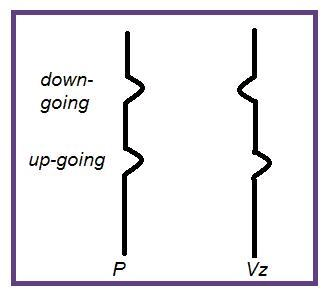|
|
|
|
Inversion of up and down going signal for ocean bottom data |
The basic idea of up-down separation using pressure and vertical particle velocity is quite simple. Hydrophones measure compressional waves (![]() ) regardless of their direction. Ocean bottom seismometers measure vertical particle velocity (
) regardless of their direction. Ocean bottom seismometers measure vertical particle velocity (![]() ) that depends on the direction of the waves measured. Figure 3 illustrates the measurement of a positive pulse coming from above and from below.
) that depends on the direction of the waves measured. Figure 3 illustrates the measurement of a positive pulse coming from above and from below.

|
|---|
|
pzfig
Figure 3. This Figure illustrates pressure |
|
|
Since the polarity of the ![]() and
and ![]() signal is the same for up-going waves and opposite for down-going waves, one can decompose the
signal is the same for up-going waves and opposite for down-going waves, one can decompose the ![]() and
and ![]() measurements into up-going (
measurements into up-going (![]() ) and down-going (
) and down-going (![]() ) pressure components:
) pressure components:
where ![]() is the receiver depth and
is the receiver depth and ![]() is an impedance factor that scales vertical velocity value to pressure value. The impedance can be offset, frequency, wavenumber, or density dependent depending on the method used. One way to perform PZ summation is in the Fourier (
is an impedance factor that scales vertical velocity value to pressure value. The impedance can be offset, frequency, wavenumber, or density dependent depending on the method used. One way to perform PZ summation is in the Fourier (
![]() )domain as
)domain as
where  is frequency in time.
is frequency in time.
![]() is the vertical wavenumber calculated from horizontal wave numbers
is the vertical wavenumber calculated from horizontal wave numbers  and
and ![]() . For a complete derivation of equation 2, please refer to Amundsen (1993).
. For a complete derivation of equation 2, please refer to Amundsen (1993).
|
|
|
|
Inversion of up and down going signal for ocean bottom data |